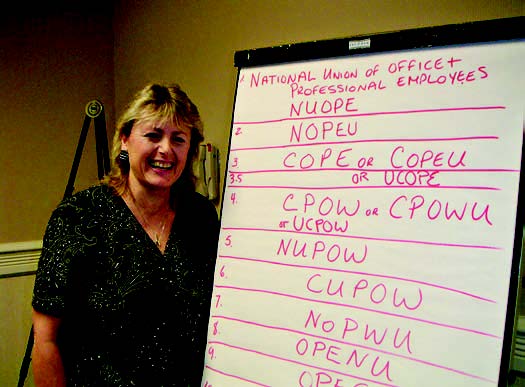It happened in a boardroom at the Westin Diplomat Hotel in Hollywood, Florida on June 20, 2004. The moment that Jerri New, then-Canadian Director of the Office and Professionals International Union (OPEIU), delivered the formal notice to OPEIU President Michael Goodwin that we were exercising our right to autonomy, our brand-new Canadian union was born.
Our name, Canadian Office and Professional Employees Union and le Syndicat des employées et employés professionnels-les et de bureau in French (COPE SEPB), would be made official just days later.
That’s just the truncated version of the story. The journey to autonomy, and the birth of COPE SEPB, is a testament of the passion, resolve, and solidarity of our members from across the country as we fought to take charge of our own destiny, protect our members, and ensure that our issues would be at the forefront.
The seeds of separation were sowed as far back as 1959 in Montréal at an OPEIU Convention when Marcel Francq, then-president of Québec-based Local 57, spoke up to address the lack of a truly Canadian union of office workers.
The 35 years or so after Francq first put the issue of Canadian identity on the radar saw gains made by OPEIU’s Canadian members on issues related to self-control and self-determination. Those included having Canadian policies be determined by Canadians, Québec correspondence written in French, two Canadian vice-presidents to be elected by Canadians, and a Canadian director with authority to speak for the Canadian membership.
The most notable gain, however, was a constitutional change in 1974 that recognized the right of the OPEIU’s locals within Canada to establish their own autonomous national union. At the time, it was hoped this change would help support organizing efforts in Canada. Indeed, in the 30 years to follow, it sat in the constitution like a dormant volcano…that is until it exploded in 2004.
At her first meeting as the new Canadian Director of OPEIU in March 2004, New knew it was the beginning of the end of our long membership in the OPEIU. The meeting was intended to discuss a proposed increasing of the per capita dues of Canadian members by two dollars a month. This was coming at a time when Canadian dollar was trading at far less compared to the American dollar.
The most egregious part, however, was that the OPEIU presented the proposal as basically a done deal. They were untouched by our concerns over the fact that, due to the low Canadian dollar, it meant in practice that Canadians would pay a larger percentage of their wages than their American counterparts. We also argued, to no avail, that as the American-based OPEIU focused their political efforts in the USA exclusively, it left the political concerns of our Canadian members unaddressed.
Our locals in Québec were left particularly vulnerable with the dues increase announcement. They had just begun a much needed, and costly, restructuring and had promised staff and members that they would not lose a single staff regardless of the cost. The dues increase would mean they would have to break that promise and lay off staff.
At a follow-up meeting a couple of weeks later, when Goodwin suggested Canadians could ‘take-it-or-leave’ the writing was on the wall and plans for autonomy were being drafted.
However, it wasn’t smooth sailing from there. We may have called Goodwin’s bluff, but the OPEIU had no intention of allowing Canadians to simply invoke the autonomy clause and walk away.
At a hastily called meeting in Las Vegas, Goodwin informed us they planned to announce an “American autonomy” motion at the June 2004 convention, which would have prevented Canadians from accessing the international defence fund and closed the Canadian autonomy clause in the constitution. It was a motion that was sure to pass given Americans represented three quarters of the OPEIU membership.
The only way out for us was a massive signature drive where we would need the majority of our 35,000 members spread across the country to sign in support of autonomy. This also needed to be accomplished in a few weeks ahead of the 2004 convention.
There are few words to appropriately describe just what a massive undertaking that was, especially given the OPEIU tried to derail the campaign in any way they could. The international union went as far as taking out full-page ads in major newspapers across Canada, and even launched a lawsuit in BC Supreme Court that was thrown out by the judge.
As the June 2004 convention approached, our Canadian leadership group was cautiously optimistic about the signature drive. While there was still some thought perhaps reconciliation with the OPEIU could be salvaged with a last-minute deal as our delegation traveled to Florida, those hopes were quickly dashed shortly after arrival.
On the day before the start of convention, word came in that 74 percent of our Canadian members had signed in support of autonomy. With that, we had won the day.
Cheer and celebration erupted as soon as we returned to our hotel after New had delivered the letter of autonomy along with a spontaneous chorus of ‘O Canada’ breaking out as our delegation waved both the Canadian flag and the Québec fleurdelisé. It was symbolic of the coming together of all our delegates across Canada and of particularly critical role our Québec locals played to lead us down this road dating all the way back to Montréal in 1959.
In November 2004, our union held our first official Canadian convention establishing our new Canadian constitution and establish our logo.
Today, the ongoing solidarity of our members from across the entire country is a tribute to the solidarity, fearlessness, and members are an ongoing tribute to the spirit, solidarity, and courage upon which our uniquely Canadian union was built on.
The symbolism behind our 20th anniversary logo
In coming up with a logo to celebrate the 20th anniversary of our union, we felt it was most critical to highlight our uniquely Canadian origins and, particularly, the critical role that our Québec locals played in our formation. We also felt it was important to honour our existing branding and logo and not stray far from our roots.
The inclusion of the maple leaf and fleurdelisé into our familiar logo serves to remind us of our historic break from the OPEIU to forge our own unique identity. Additionally, having the maple leaf placed within the blue and the fleurdelisé within the red, which is the reverse of how they are typically coloured elsewhere, is symbolic of our coming together in solidarity.
What’s in a name?
Once the dust was (mostly) settled from the breakaway from the OPEIU, deciding on the new name of our uniquely Canadian union was a fun task that fell to the delegates assembled in Florida. A photo captured from their first meeting as a Canadian union reveals several acronyms under consideration. The full names can likely be easily guessed.
The word ‘national’ appeared to be an early favourite as part of the name although ultimately, and probably for the best, it was dropped in favour of the word ‘Canadian.’
Some of those acronyms included: NUOPE, NOPEU, CPOW, NUPOW, CUPOW, NOPWU, and OPENU.
In 2015, Local 378 in British Columbia opted to rebrand as MoveUP, the Movement of United Professionals to better reflect the evolving perception of the membership.




